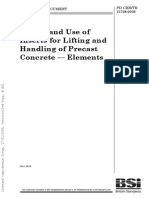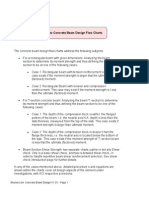0 ratings0% found this document useful (0 votes)
127 viewsSteel Stacks
Steel Stacks
Uploaded by
dicktracy11Structural Steel Stack Design
Copyright:
© All Rights Reserved
Available Formats
Download as PDF or read online from Scribd
Steel Stacks
Steel Stacks
Uploaded by
dicktracy110 ratings0% found this document useful (0 votes)
127 views2 pagesStructural Steel Stack Design
Copyright
© © All Rights Reserved
Available Formats
PDF or read online from Scribd
Share this document
Did you find this document useful?
Is this content inappropriate?
Structural Steel Stack Design
Copyright:
© All Rights Reserved
Available Formats
Download as PDF or read online from Scribd
Download as pdf
0 ratings0% found this document useful (0 votes)
127 views2 pagesSteel Stacks
Steel Stacks
Uploaded by
dicktracy11Structural Steel Stack Design
Copyright:
© All Rights Reserved
Available Formats
Download as PDF or read online from Scribd
Download as pdf
You are on page 1of 2
308 Chinneye
the sane dimensions. An approximate natural frequency can be determined from Eg, (10)
byasing for wy the weight of the shell plu lining, aluided by the thikmess ofthe plate R
‘The weielt and thickness should be taken a about one-fourth the height above the base ‘i
Base flexibility may need to be considered in determining frequency. For example,
when stack are supported on 4 roof structure ofa steal frame, the translational end ole: i:
tional spring constants ofthe support must be taken into account, n
STEEL STACKS. cs
‘There are many types of steel stacks, including self-xapported, guyed, and braced. The
Choice ofa particular type should be based on the evalvaton of ts comparative cots snd z
the site conditions. The three proble types commonly used are shown in Fig. 5. Short y
Stacks, loss than [00 Thigh, may be straight cylinders. For tller stacks «bell base may *
eused to reduce plate thickness and anchor-bolt size, The bell heights usually between i
‘one-fourth and one-third of the total stack height, The diameter of the fared bare Dy ic 4
tually about Te to Di tines the evlinder diameter
‘Most steel stacks are bal fom plate conforming to ASTM AS6. In some cases, A242, a
ASSB.AI31B or CS, A285C, oF other grades of steel have beon uscd as dictated by indi f
‘ial experience and specie requirements stiffeners sre normally AS6. Steel fr tacks x
Incold climates should have a low transition temperature (See, 4) ©
“The Hee! stack and its anchorage should he designed forthe lows discussed in preced:
ing articles. When subjected to wind and/or earthquake loads, the stack may be treated is
fava beam column and analyzed by the conventional beam theory. Except in guyed and
braced stacks, nonuniform temperature differentials wall not Induce bending mements,
Partcfar anton regired athe design of reinforcing tthe cove-to-eybader june
tion and atthe breoching epening. :
"To reduce heat ls, insuation of the exterior surface of wlind steel stack, including
the projecting Hanges of al attachments, is recommended. This is common practice in 1
England to reduce soot fallout, Proper ning should be applied tothe interior surface of
the shel to protect the bare steel from high temperature, abrasion, and corrosion from
the fue gases, The weight of insulation and ling should be taken into account in the 7
frequenc) ealcultion for resonance under the lined condition. Unless an Integral shot
{rete or brick Unng fs used, no eredt should be given to th lining in calculating stack
‘fifa.
'ASTM STS-1" provides the requirements and guidelines for desig, fabrication, ere
tion and maintenance of steel stacks and thelr appurtenances
9, Algnable Svesses The allowable longitudinal compressive stresses due to vertical
load and bending moment cxn be determined by”
F-XY as)
where
/ 0.062550/R
X=) 05IF,— hie, — A)
lose,
(i, ooseyny
im (Se oar, )
p eae
y=|__s1,600
I
L
eo for => 60 and F, 50 ksi
£, = yield strength at mean shall temperature, ksi
E. = proportions! limi a mean shell temperature, ksi: may be taken as 0.7,
1B fmodulus of elasticity at mean shell temperatire, ks
CircumtorntialStitenere 30-8
{= shellplate thickness, in at the seetton under consideration
A= radius of shel, i
L = length of stack between points of lateral support, For a self-supporting stack, E
should be taken as the effctive length, e., = 2% stack height,
+ = radius of gyration = 0.707R, in
‘The factor Yin Eq, (14) i intended to account fora possible interaction of cylindrical
shell bueling. which depends on ¢/R, and coluina buekling, which depends on L/r
"The allowable strss given by Eq, (1d) s based on a factor of safety of and ie suggested
{or load combinations which inelude either mind or earthquake forces
Because of possible corrosion the computed roquired thickness should be increased,
The allowance may vary from M to X 1a, depending oa the properties of fue gases, the
{types af insulation and lining provided, and the operating gas temperature. Including the
corrosion allowance, it is recommended that the shell thickness be not less than %e in for
“alined stacks and n for lined stacks. Outstanding elements of rlled shapes and bil
‘up members should have & minimum thickest of in
“0, Cone-t-Cylner Junction A stifening rag is required at the junction of the cone
apd the straight cylinder sections of stacks Tes normally designed to resist the creum
ferential compression that results from the vertial los and bending maments atthe
junction, Where external pressure dao to stack drafts significant, the resulting additional
‘reumferential forces should also be considered.
"The matimem vertial force N, per unit length of elrcumference in the eylinder a the
junction is
wow
Nee a3)
there W = avi od at juneion
M12 sind or ler momenta junction
The total secure compton Qa he Fng i
Qe RIN, tan 0 + 0 TRRAVAR + sec VERB) «8
there # = sate angle between cone wall and linder
1, utr! peste porunt aes
f= snes of endo wall fo
1. Uieknes of cone walkin
The cequet aren and momento inertia ofthe
an
as)
‘The allowable ring compression Fin Ba. (17) usually limited to 8000 psito minimize
the secondary vertical bonding stresses, For stacks of lameters greater than 13, oF
whore higher values of F, are used. it would be advisable to evaluate the secondary
Stresses. In addition, bending stresses due to tho circumferential variation in wind pres:
sure should be checked by Eas. (7).
In determining the section properties of the stifening ring the area ofa partion of the
shell Fig. 6} can be inchuded, but the area wo included should not exceed the area ofthe
fing itselfra ensure a nominalsizestifener. The maximum permisible longitudinal com
pressive stresses in the eono may be determined by Eq, (14) with the horizontal radius
Feplaced by the cone rads Fsec
41. Grcomtarenta Stlenars_In addition tothe stiffener atthe cone-cylindor junction a
stfener ls required at the top of the stack, Intermediate ring stiffeners may also be
Tested, The purpose of such stilfening sto prevent excessive deformations of the stack
‘hell under wind pressure and to provide alee steactoral resistance to negative draft
Tntormedite sfener spacing £, can be determined by
[ee
L= 10 \/m a9)
V BP
You might also like
- The Subtle Art of Not Giving a F*ck: A Counterintuitive Approach to Living a Good LifeFrom EverandThe Subtle Art of Not Giving a F*ck: A Counterintuitive Approach to Living a Good LifeRating: 4 out of 5 stars4/5 (5978)
- The Gifts of Imperfection: Let Go of Who You Think You're Supposed to Be and Embrace Who You AreFrom EverandThe Gifts of Imperfection: Let Go of Who You Think You're Supposed to Be and Embrace Who You AreRating: 4 out of 5 stars4/5 (1110)
- Never Split the Difference: Negotiating As If Your Life Depended On ItFrom EverandNever Split the Difference: Negotiating As If Your Life Depended On ItRating: 4.5 out of 5 stars4.5/5 (893)
- Hidden Figures: The American Dream and the Untold Story of the Black Women Mathematicians Who Helped Win the Space RaceFrom EverandHidden Figures: The American Dream and the Untold Story of the Black Women Mathematicians Who Helped Win the Space RaceRating: 4 out of 5 stars4/5 (932)
- Grit: The Power of Passion and PerseveranceFrom EverandGrit: The Power of Passion and PerseveranceRating: 4 out of 5 stars4/5 (619)
- Shoe Dog: A Memoir by the Creator of NikeFrom EverandShoe Dog: A Memoir by the Creator of NikeRating: 4.5 out of 5 stars4.5/5 (545)
- The Hard Thing About Hard Things: Building a Business When There Are No Easy AnswersFrom EverandThe Hard Thing About Hard Things: Building a Business When There Are No Easy AnswersRating: 4.5 out of 5 stars4.5/5 (356)
- Her Body and Other Parties: StoriesFrom EverandHer Body and Other Parties: StoriesRating: 4 out of 5 stars4/5 (831)
- Elon Musk: Tesla, SpaceX, and the Quest for a Fantastic FutureFrom EverandElon Musk: Tesla, SpaceX, and the Quest for a Fantastic FutureRating: 4.5 out of 5 stars4.5/5 (476)
- The Emperor of All Maladies: A Biography of CancerFrom EverandThe Emperor of All Maladies: A Biography of CancerRating: 4.5 out of 5 stars4.5/5 (275)
- The Little Book of Hygge: Danish Secrets to Happy LivingFrom EverandThe Little Book of Hygge: Danish Secrets to Happy LivingRating: 3.5 out of 5 stars3.5/5 (424)
- The World Is Flat 3.0: A Brief History of the Twenty-first CenturyFrom EverandThe World Is Flat 3.0: A Brief History of the Twenty-first CenturyRating: 3.5 out of 5 stars3.5/5 (2272)
- The Yellow House: A Memoir (2019 National Book Award Winner)From EverandThe Yellow House: A Memoir (2019 National Book Award Winner)Rating: 4 out of 5 stars4/5 (99)
- Devil in the Grove: Thurgood Marshall, the Groveland Boys, and the Dawn of a New AmericaFrom EverandDevil in the Grove: Thurgood Marshall, the Groveland Boys, and the Dawn of a New AmericaRating: 4.5 out of 5 stars4.5/5 (270)
- The Sympathizer: A Novel (Pulitzer Prize for Fiction)From EverandThe Sympathizer: A Novel (Pulitzer Prize for Fiction)Rating: 4.5 out of 5 stars4.5/5 (125)
- Team of Rivals: The Political Genius of Abraham LincolnFrom EverandTeam of Rivals: The Political Genius of Abraham LincolnRating: 4.5 out of 5 stars4.5/5 (235)
- A Heartbreaking Work Of Staggering Genius: A Memoir Based on a True StoryFrom EverandA Heartbreaking Work Of Staggering Genius: A Memoir Based on a True StoryRating: 3.5 out of 5 stars3.5/5 (232)
- On Fire: The (Burning) Case for a Green New DealFrom EverandOn Fire: The (Burning) Case for a Green New DealRating: 4 out of 5 stars4/5 (75)
- Lifting Lug CalculationDocument5 pagesLifting Lug CalculationEm Mar100% (2)
- The Unwinding: An Inner History of the New AmericaFrom EverandThe Unwinding: An Inner History of the New AmericaRating: 4 out of 5 stars4/5 (45)
- SDRM 1519Document1 pageSDRM 1519dicktracy11No ratings yet
- PD CEN-TR 15728 2008 Inserts For Lifting and Handling Precast ElementsDocument54 pagesPD CEN-TR 15728 2008 Inserts For Lifting and Handling Precast Elementsdicktracy11100% (1)
- Soil Loads On PipelinesDocument10 pagesSoil Loads On Pipelinesdicktracy11No ratings yet
- Concrete Beam Design Flow ChartDocument16 pagesConcrete Beam Design Flow Chartdicktracy11No ratings yet
- Bracket DesignDocument18 pagesBracket Designdicktracy11100% (2)
- 13 Songs You Wish You FoundDocument1 page13 Songs You Wish You Founddicktracy11No ratings yet















































